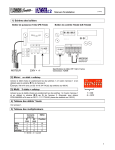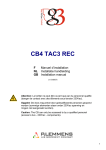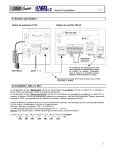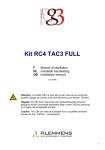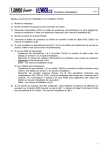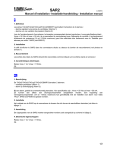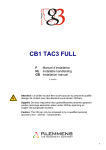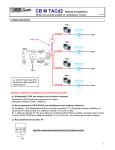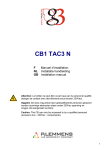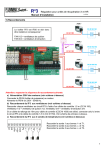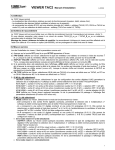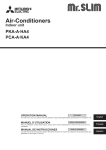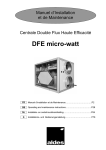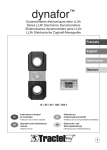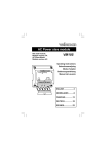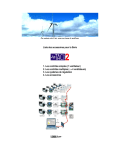Download Ventilator met constant debiet in functie van een extern 0
Transcript
ls2 Manuel d'installation (cid 005161, 360006) (v.01/04) Définition: Boîtier de contrôle qui permet de lier le débit d’air à un signal d’entrée analogique (LS) sans nécessiter de PC pour sa configuration. Il permet de fonctionner en liaison avec un signal 0-10V externe (sonde, régulateur, …) ou être utilisé comme Slave en étant lié au signal de débit 0-4,5V d’un boîtier CB TACxx2 Master. 1) Schéma des boîtiers Boîtier de puissance TAC2 (PB TAC2) Boîtier de contrôle TACls2 1 2 3 4 5 6 7 8 CONTROLE PUISSANCE 00W_H L N TO FAN BOX 1 2 GG 3 4 5 6 G 7 8 NN N DD D SOFTSTOP CLOSED=RUN OPEN=STOP MOTEUR 230V + Specifications du câble: UTP / Cat.5 / 8 wires Connecteurs : RJ45/8 2) Lier le débit à un signal externe 0-10V (DS1 = 0) a) Mettre le dip-switch 1 sur 0 (off). b) Définir la logique du lien entre le signal d’entrée et le débit: Positive: Le débit augmente lorsque la valeur du signal d’entrée augmente. (0V = débit minimum, 10V = débit maximum) Mettre le dip-switch 2 sur 0 (off). Négative: Le débit diminue lorsque la valeur du signal d’entrée augmente. (0V = débit maximum, 10V = débit minimum) Mettre le dip-switch 2 sur 1 (on). c) Sélectionner le débit minimum de votre application à l’aide des dip-switches 3-4 (4 possibilités). Ces valeurs sont définies comme des pourcentages du débit maximum nominal (voir § e)) du ventilateur: DS 3-4 00 01 10 11 % débit maximum nominal ventilateur 0 % (càd 100 m³/h) 10 % 20 % 30 % 1 d) Sélectionner le débit maximum de votre application à l’aide des dip-switches 5-6 (4 possibilités). Ces valeurs sont définies comme des pourcentages du débit maximum nominal (voir § e)) du ventilateur: DS 5-6 00 01 10 11 % débit maximum nominal ventilateur 100 % 90 % 80 % 70 % e) Débit maximum nominal par type de ventilateur: DD 9-7TH 1/2 Débit max. 720054 2000 DD 9-9 1/2 720055 2900 DP 9-9 1/1 S 10-4TH 1/3 Débit max. f) 720060 5700 720071 1000 DD 10-10 3/4 720056 3800 DS 10-4 1/2 720061 1500 DD 11-11 1/1 720057 4400 DS 11-4 1/2 720062 1900 DP 6-6 1/2 720058 2200 DS 12-5 3/4 720063 2600 DP 9-7TH 1/1 720059 3600 F 280-114 1/3 720077 1300 DP 9-7TH 1/2 720011 3000 (K)DF 280-114 1/2 720078 1700 Il est possible d’activer un multiplicateur égal à 50% du lien établi en fermant le contact K3 (entre les bornes 5 et 6). Détail du raccordement: voir annexe 1. g) Raccorder selon schémas repris en annexe 1. h) Initialisation de l’alarme de pression (si nécessaire) : voir §4).1. 3) Lier le débit à un signal externe 0-4,5V (DS1 = 1) – configuration maître/esclave Le but est de lier le débit du boîtier de contrôle (esclave) à celui d’un autre boîtier (maître) en récupérant son signal de sortie représentatif du débit (utiliser les mêmes types de ventilateurs). a) Mettre le dip-switch 1 sur 1 (on). b) Sélectionner le rapport de débit entre le boîtier maître et esclave à l’aide des dip-switches 2 à 4. 111 Débit esclave / débit maître (%) 120 110 110 101 100 100 95 011 90 010 85 001 80 000 70 DS 2-3-4 c) Il est possible d’activer un multiplicateur égal à 50% du lien établi en fermant le contact K3 (entre les bornes 5 et 6). Détail du raccordement: voir annexe 1. d) Raccorder selon schémas repris en annexe 1. e) Initialisation de l’alarme de pression (si nécessaire): voir §4).1. 2 4) Alarmes Le boîtier de contrôle TACls2 comprend 3 types d’alarme: (Exemples de schémas de raccordement: voir annexe 1. - une alarme sur la variation de pression. - une alarme signalant une panne du ventilateur. - des alarmes d’initialisation. ). 4.1 Alarme sur la pression. Cette alarme permet de signaler à l’utilisateur une variation de pression par rapport à la pression de référence (selon courbe système). Lors de l’enclenchement de cette alarme, la LED2 est allumée et le transistor branché entre les bornes G et 2 du boîtier de contrôle est conducteur. Comment mémoriser la pression de référence Paréf : a) Installer le ventilateur dans son application réelle. b) Ouvrir le boîtier de contrôle TACls2, appuyer sur le bouton SW2 jusqu’à ce que la LED1 s’allume. Le processeur adapte automatiquement le débit pour atteindre celui d’initialisation d’alarme (60% du débit maximum de l’application), calcule la pression du système (LED1 allumée) et la mémorise dès qu’un calcul stabilisé a pu être effectué. A ce moment, la LED1 s’éteint, signalant la fin de mémorisation de Paréf. Au terme de l’initialisation, 2 types de problèmes peuvent survenir (signalés par le clignotement des LED 1 et 2) : Type d’alarme A B Descriptif Débit réel < débit demandé : le point de fonctionnement est situé à un niveau de pression supérieur à la pression maximale admissible au débit demandé / débit non encore atteint suite à un démarrage. Pression trop instable LED 1 LED 2 7x 1x 8x 1x Dans les 2 cas, Paréf ne peut être mémorisée et le moteur est mis en mode “softstop”. Il faut alors débrancher puis rebrancher le câble entre le boîtier de contrôle et de puissance (connecteur RJ45). Le boîtier fonctionnera alors sans alarme sur la pression. Si une initialisation doit malgré tout être faite, veillez à régler un point de fonctionnement stable et compris dans la zone de travail du ventilateur (diminuer la pression, modifier le débit, placer un autre type de ventilateur,…) Comment fixer l’incrément: On peut choisir un incrément parmi 4 à l’aide des dip-switches 7 et 8: DS 7-8 Delta 00 50 01 80 10 120 11 150 0=OFF - 1=ON Cet incrément correspond au débit d’initialisation de l’alarme, soit 60% du débit maximum de l’application. 4.2 Alarme sur le fonctionnement du ventilateur. Cette alarme signale un disfonctionnement du ventilateur. Lors de l’enclenchement de cette alarme, la LED1 est allumée et le transistor branché entre les bornes G et 1 du boîtier de contrôle est conducteur. 4.3 Alarmes d’initialisation Lors de la mise sous tension du ventilateur, 5 types de problèmes peuvent se produire : Descriptif INIT1: Ventilateur de génération 2 non « reconnu » par le boîtier de contrôle INIT2: Ventilateur de génération 1 INIT3: Pas de signal “vitesse de rotation” venant du moteur INIT4: Altération des données du circuit INIT5: Problème de détection du type de ventilateur LED 1 6x 4x 5x 1 2,3,9 x 10 x LED 2 1x 1x 1x 1x 1x Dans tous les cas, retirer le câble de liaison RJ45 et le remettre. Si le problème persiste : - Dans les 2 premiers cas (INIT1 et 2), le boîtier de contrôle n’est pas adapté au type de ventilateur. Veillez à remplacer soit le ventilateur par un modèle adéquat, soit le type de boîtier de contrôle. 3 - Une alarme de type “INIT3” signale un manque de signal de vitesse de rotation venant du moteur. Remplacez le boîtier de puissance TAC2. Si le problème persiste remplacer le câble RJ45. Si le problème persiste encore, remplacer le boîtier de contrôle. Si le problème persiste toujours, remplacer le ventilateur. - Une alarme de type “INIT4” signale une altération des données inclues dans la mémoire du boîtier TACls2. Dans un tel cas, le boîtier de contrôle doit être remplacé. - En cas d’alarme de type “INIT5”, remplacer le boîtier de contrôle. Si le problème persiste remplacer le ventilateur. 5) Signaux de sortie Signal entre G-7: 0-4,5 Vdc = 0-débit max. Signal entre G-8: 0-4,5 Vdc = 0-Pa max. Impédance min. = 100 MΩ. Débit max. Pres. max. DD 9-7TH 1/2 720054 2000 630 DD 9-9 1/2 720055 2900 780 DD 10-10 3/4 720056 3800 1050 DD 11-11 1/1 720057 4400 1070 DP 6-6 1/2 720058 2200 450 Débit max. Pres. max. DS 11-4 1/2 720062 1900 950 DS 12-5 (K)DF 280-114 (K)DF 280-114 3/4 1/3 1/2 720063 720077 720078 2600 1300 1700 1310 525 575 DP 9-7TH DP 9-7TH 1/1 1/2 720059 720011 3600 3000 630 575 DP 9-9 DS 10-4 TH DS 10-4 1/1 1/3 1/2 720060 720071 720061 5700 1000 1500 900 585 750 6) Schémas de raccordement Voir annexe 1. 7) Données techniques Alimentation: 230VAC (entre 208V et 240V) - Frequence : 50/60Hz Mise à terre: ! OBLIGATOIRE ! Protection éléctrique: Le moteur est auto-protégé contre les surcharges. Il n'est donc pas nécessaire de prévoir une protection électrique contre les surcharges. Une simple protection contre les court-circuits suffit et doit être sélectionnée en respectant les spécifications suivantes : - pointe à l'enclenchement de 150 A (20A avec PB S) pendant 2 à 4 millisecondes (si disjoncteur : sélectionner une courbe de déclenchement de type D – pouvoir de coupure 10.000A - AC3). Il est obligatoire d'utiliser la fonction softstop afin d'éviter cette pointe. - nous recommandons une protection de classe AM. Calibre de la protection/moteur Type 1/3 HP 1/2 HP 3/4 HP 1/1 HP Calibre 4A 4A 8A 10A Exemples indicatifs et non exhaustifs de sélection de : a) cartouches fusibles AM (10x38mm), b) disjoncteurs magnétothermiques : courbes de déclenchement D – pouvoir de coupure 10.000 A. (8A inexistant : mettre 10A) a) b) Calibre Vynckier Merlin Gérin Calibre Legrand Télémécanique Huppertz 2A réf : 099/37202-000 réf : 25111 2A réf. :130.02 réf. : DF2-CA02 réf. : D440102 4A réf : 099/37204-000 réf : 25113 4A réf. :130.04 réf. : DF2-CA04 réf. : D440104 8A n'existe pas n'existe pas 8A réf. :130.08 réf. : DF2-CA08 réf. : D440108 10A réf : 099/37210-000 réf : 25115 10A réf. :130.10 réf. : DF2-CA10 réf. : D440110 Classe d'isolation Thermique : B / Mécanique : IP44 - les connecteurs doivent être placés vers le bas. Températures ambiantes: -10°C / +55°C Conformités: approuvé CE – UL 4 ls2 Installatiehandleiding (v.01/04) Definitie: Een controlebox waarmee het luchtdebiet aan een analoog ingangsignaal kan worden gekoppeld (LS) zonder tussenkomst van een PC. Er kan gewerkt worden met een extern 0-10V signaal (sonde, regelaar,…) of in een meester-slaaf configuratie die aan het 0-4,5V signaal van een CB TACxx2 wordt gelinkt. 1) Schema’s Vermogensbox TAC2 (PB TAC2) Controlebox TACls2 1 2 3 4 5 6 7 8 CONTROLE PUISSANCE 00W_H L N TO FAN BOX 1 2 GG 3 4 5 6 G 7 8 NN N DD D SOFTSTOP CLOSED=RUN OPEN=STOP MOTEUR 230V + Specificaties van de kabel: UTP / Cat.5 / 8 wires Aansluitingen : RJ45/8 2) Het debiet aan een extern 0-10V signaal koppelen (DS1 = 0) a) Zet dip-switch 1 op 0 (off). b) Definieer de relatie tussen het ingangsignaal en het debiet: Positief: Het debiet stijgt als het ingangsignaal stijgt. (0V = minimum debiet, 10V = maximum debiet) Zet dip-switch 2 op 0 (off). Negatief: Het debiet daalt als het ingangsignaal stijgt. (0V = maximum debiet, 10V = minimum debiet) Zet dip-switch 2 op 1 (on). c) Kies het minimumdebiet van uw toepassing met behulp van de dip-switches 3-4 (4 mogelijkheden). Deze waarden zijn gedefinieerd als een percentage van het nominale maximumdebiet (zie §e)) van de ventilatoren. DS 3-4 00 01 10 11 % nominaal maximum debiet van de ventilator 0 % (dwz 100 m³/u) 10 % 20 % 30 % 5 d) Kies het maximumdebiet van uw toepassing met behulp van dip-switches 5-6 (4 mogelijkheden). De waarden zijn gedefinieerd als een percentage van het nominale maximumdebiet (zie §e)) van de ventilator: DS 5-6 00 01 10 11 % nominaal maximum debiet van de ventilator 100 % 90 % 80 % 70 % e) Nominaal maximumdebiet per type ventilator: DD 9-7TH 1/2 Max debiet DD 9-9 1/2 720054 2000 720055 2900 DP 9-9 1/1 S 10-4TH 1/3 Max debiet f) 720060 5700 720071 1000 DD 10-10 3/4 DD 11-11 1/1 720056 3800 DS 10-4 1/2 720057 4400 DS 11-4 1/2 720061 1500 720062 1900 DP 6-6 1/2 720058 2200 DS 12-5 3/4 720063 2600 DP 9-7TH 1/1 DP 9-7TH 1/2 720059 3600 F 280-114 1/3 720077 1300 720011 3000 (K)DF 280-114 1/2 720078 1700 Het is mogelijk om een multiplicator te activeren die gelijk is aan 50% van de vastgelegde relatie, en dit door contact K3 te sluiten (tussen klemmen 5 en 6). Aansluiting zie bijlage 1. g) Aansluiten volgens de schema’s in bijlage 1. h) Initialiseren van het drukalarm (indien nodig, zie § 4).1. 3) Het debiet koppelen aan een extern 0-4,5V signaal (DS1 = 1) - meester/slaaf configuratie Het doel is om het debiet van de controlebox (slaaf) te koppelen aan dat van een andere controlebox (meester). Het debiet van de ‘meester’ ventimator zal dan als representatief uitgangsignaal dienen voor dat van de ‘slaaf’ ventilator (gebruik dezelfde type ventilatoren). a) Zet dip-switch 1 op 1 (on). b) Kies de relatie tussen het meester en het slaaf debiet met behulp van de dip-switches 2 tot 4. 111 Debiet slaaf / debiet meester (%) 120 110 110 101 100 100 95 011 90 010 001 85 80 000 70 DS 2-3-4 c) Het is mogelijk om een multiplicator te activeren die gelijk is aan 50% van de vastgelegde relatie, en dit door contact K3 te sluiten (tussen klemmen 5 en 6). Aansluiting zie bijlage 1. d) Aansluiten volgens de schema’s in bijlage 1. e) Initialiseren van het drukalarm (indien nodig, zie § 4).1. 6 4) Alarm De TACd2 kast bevat 3 alarm types : (Voorbeelden aansluitingsschema: zie bijlage 1. ). - alarm op drukwijziging - ventilator-pech alarm - initialisatie alarmen 4.1 Alarm op drukwijziging: Dit alarm signaleert een drukwijziging op basis van de referentiedruk. Bij een alarm licht LED2 op en geleidt de transistor van de controlekast tussen de klemmen G en 2. De referentie druk Paref in het geheugen opslaan : a) Laat de ventilator in zijn reële toepassing draaien. b) De controlekast TACls2 openen en op de knop SW2 drukken tot LED1 oplicht. De processor aanpast automatisch het debiet om 60% van de maximum debiet van de toepassing te halen, berekent automatisch de overeenstemmende druk voor dit debiet (LED1 aan) en brengt deze in het geheugen zodra het systeem gestabiliseerd is (LED1 uit). Na initialisatie kunnen 2 problemen optreden (LED 1 en LED2 knipperen) : Alarm type A B Beschrijving Debiet < gewenst : de druk is hoger dan de maximaal toelaatbare druk voor het gewenste debiet / debiet nog niet bereikt na starten. Druk te veranderlijk. LED 1 LED 2 7x 1x 8x 1x In beide gevallen kan Paref niet in het geheugen gebracht worden en wordt de motor in “softstop” geschakeld. Het verbindingssnoer tussen de controlekast en de vermogenkast (RJ45 connector) verwijderen en terugplaatsen. De controlekast zal dan zonder alarm voor drukwijziging werken. Indien een dergelijk alarm noodzakelijk is moet een stabiel werkingspunt ingesteld worden dat in het werkingsgebied van de ventilator ligt. (druk en/of debiet aanpassen, een andere type ventilator gebruiken, ...). Hoe het increment instellen: Er kunnen 4 incrementen (voor een debiet = 60 van maximaal debiet van de toepassing) gekozen worden door middel van dip-switches 7 en 8: DS 7-8 00 01 10 11 0=OFF - 1=ON ∆Pa 50 80 120 150 4.2 Ventilator pechalarm: Dit alarm signaleert een pech van de ventilator. Bij alarm licht LED1 op en geleidt de transistor van de controlekast tussen de klemmen G en 1. 4.3 Initialisatie alarmen: Bij het inschakelen van de ventilator kunnen 5 problemen optreden : Beschrijving INIT1: Ventilator van generatie 2 wordt niet herkend door de controlebox INIT2: Ventilator van generatie 1 INIT3: Er komt geen toerentalsignaal door van de motor INIT4: Verandering van de gegevens van het D2 circuit INIT5: Probleem in detectie van de type ventilator LED 1 6x 4x 5x 1,2,3,9 x 10 x LED 2 1x 1x 1x 1x 1x Probeer altijd eerst om de RJ45 kabel opnieuw te bevestigen. Indien het probleem aanhoudt : - In de eerste 2 gevallen (INIT1 en 2) is de controlebox niet aangepast aan het type ventilato. U dient ofwel de ventilator ofwel de controlebox te vervangen. - Een alarm type INIT3 geeft aan dat er geen toerentalsignaal van de motor komt. Vervang de TAC2 vermogensbox. Indien het probleem aanhoudt, vervang de RJ45 kabel. Indien het probleem aanhoudt, vervang de TACls2 controlebox. Indien het probleem nog steeds aanhoudt, vervang de ventilator. - Een alarm type INIT4 geeft aan dat er zich een wijziging heeft voorgedaan in het geheugen van de TACls2. In een dergelijk geval moet de controlebox vervangen worden. 7 - Een alarm type INIT5 geeft aan dat er een probleem in de detectie van het type ventilator is. Vervang de TACls2 controlebox. Indien het probleem aanhoudt, vervang de ventilator. 5) Uitgangssignalen Signaal tussen G-7: 0-4,5 Vdc = 0–max. debiet. Signaal tussen G-8: 0-4,5 Vdc = 0-Pa max. Min. impedance = 100 MΩ. Max. debiet Max. druk DD 9-7TH 1/2 720054 2000 630 DD 9-9 1/2 720055 2900 780 DD 10-10 3/4 720056 3800 1050 DD 11-11 1/1 720057 4400 1070 DP 6-6 1/2 720058 2200 450 Max. debiet Max. druk DS 11-4 1/2 720062 1900 950 DS 12-5 (K)DF 280-114 (K)DF 280-114 1/3 1/2 3/4 720063 720077 720078 2600 1300 1700 1310 525 575 DP 9-7TH DP 9-7TH 1/1 1/2 720059 720011 3600 3000 630 575 DP 9-9 DS 10-4 TH DS 10-4 1/1 1/3 1/2 720060 720071 720061 5700 1000 1500 900 585 750 6) Aansluitingsschema's Zie bijlage 1. 7) Technische gegevens Voeding: 230VAC (tussen 208V en 240V) - Frequency : 50/60Hz Aarding: ! VERPLICHT ! Electrische beveiliging: De motor is intern beveiligd tegen overbelasting.Het is dus niet nodig een electrische beveiliging tegen overbelasting te monteren. Een eenvoudige beveiliging tegen kortsluiting is voldoende en deze moet rekening houden met : - piekstroom van 150 A (20A met PB S) gedurende 2 à 4 milliseconden bij het starten (indien met schakelaar : een uitschakelcaracteristiek van het type D selecteren - kortsluitvermogen 10.000A - AC3). Het is verplicht de softstop functie te gebruiken om deze piekstroom te vermijden; - wij raden een beveiliging classe AM aan. Kaliber van de beveiliging/motor Type 1/3 HP 1/2 HP 3/4 HP 1/1 HP Kaliber 4A 4A 8A 10A Indicatieve voorbeelden van de selectie van : a) zekeringspatronen AM (10x38mm), b) magneto-thermische schakelaars : uitschakelcaracteristiek van het type D - kortsluitvermogen 10.000 A (8A bestaat niet : 10A gebruiken). a) b) Kaliber Legrand Télémécanique Huppertz Kaliber Vynckier Merlin Gérin 2A 2A réf. :130.02 réf. : DF2-CA02 réf. : D440102 réf : 099/37202-000 réf : 25111 réf. :130.04 réf. : DF2-CA04 réf. : D440104 réf : 099/37204-000 réf : 25113 4A 4A réf. :130.08 réf. : DF2-CA08 réf. : D440108 bestaat niet bestaat niet 8A 8A 10A réf. :130.10 réf. : DF2-CA10 réf. : D440110 10A réf : 099/37210-000 réf : 25115 Isolatieklasse Thermisch : B / Mechanisch : IP44 - de connectoren moeten naar beneden geplaatst worden. Omgevingstemperatuur: -10°C / +55°C Gelijkvormigheid: goedgekeurd CE - UL 8 ls2 Installation manual (cid 005161, 360006) (v.01/04) Definition: This control device allows to link the constant airflow of the fan to an analogical entry signal without the use of a PC: the Link to Signal (LS) control box. The CBls2 is designed to operate with a 0-10V signal (sensor, regulator, …) or to be used as a slave linked to the 0-4,5V output signal coming from another CB TACxx2 (master). 1) Schematic Power Box TAC2 (PB TAC2) Control Box TACls2 1 2 3 4 5 6 7 8 CONTROLE PUISSANCE 00W_H L N TO FAN BOX 1 2 GG 3 4 5 6 G 7 8 NN N DD D SOFTSTOP CLOSED=RUN OPEN=STOP MOTEUR 230V + Cable specification: UTP / Cat.5 / 8 wires Connector : RJ45/8 2) Link constant airflow to 0-10V signal (DS1 = 0) a) Set dip-switch 1 on 0 (off). b) Define logical relation between airflow and signal: Positive: Negative: Airflow increases as signal value increases. (0V = minimum airflow, 10V = maximum airflow) Set dip-switch 2 on 0 (off). Airflow decreases signal value increases. (0V = maximum airflow, 10V = minimum airflow) Set dip-switch 2 on 1 (on). c) Select minimum airflow of the application using dip-switches 3-4 (4 possibilities). This value is defined as a percentage of the fan’s maximum airflow see § e): DS 3-4 00 01 10 11 % fan’s maximum airflow Minimum airflow (100 m³/h) 10 % 20 % 30 % 9 d) Select maximum airflow for the application using dip-switches 5-6 (4 possibilities). This value is defined as a percentage of the fan’s maximum airflow (see § e): DS 5-6 00 01 10 11 % fan’s maximum airflow 100 % 90 % 80 % 70 % e) Maximum airflow for each fan type: DD 9-7TH 1/2 ID code Max airflow. DD 9-9 1/2 720054 2000 720055 2900 DP 9-9 1/1 S 10-4TH 1/3 ID Code Max airflow f) 720060 5700 DD 10-10 3/4 720056 3800 DS 10-4 1/2 720071 1000 720061 1500 DD 11-11 1/1 DP 6-6 1/2 720057 4400 DS 11-4 1/2 720058 2200 DS 12-5 3/4 720062 1900 720063 2600 DP 9-7TH 1/1 720059 3600 F 280-114 1/3 720077 1300 DP 9-7TH 1/2 720011 3000 (K)DF 280-114 1/2 720078 1700 By using the K3 contact you can activate a 50% multiplier to the requested airflow. This can be used for « night » position for instance. See detailed wiring in appendice 1. g) Connect as per schematic of appendix 1. h) It is possible to set up a pressure alarm (without sensors): see §4.1. 3) Link airlow to a 0-4,5V (DS1 = 1) – master/slave configuration It is possible to use this control box to set up a fan as a ‘slave’ of another ‘master’ fan. This feature will setup the CB to receive the 0-4.5V signal representing the airflow coming from another (master) CB. This feature can only be used when both fans (master and slave) are of the same type. a) Set dip-switch 1 on 1 (on). b) Select airflow relation between master airflow and slave airflow with dip-switches 2 to 4. 111 ‘Slave’ airflow / ‘Master’ airflow (%) 120 110 110 101 100 100 95 011 010 90 85 001 80 000 70 DS 2-3-4 c) By using the K3 contact you can activate a 50% multiplier to the requested airflow. This can be used for « night » position for instance. See detailed wiring in appendice 1. d) Connect as per schematic of appendix 1. e) It is possible to set up a pressure alarm (without sensors): see §4.1. 10 4) Alarm The TACls2 allows 3 types of alarms: (Examples of wiring diagram: see appendix 1. - Pressure variation alarm - Motor failure alarm - Initialization alarms ). 4.1 Pressure rise alarm: This alarm will inform the user of a pressure rise compared to the reference (initial) pressure. When this warning is engaged, LED2 is lit and the transistor between terminal G and 2 of the control board is conductive. How to set the reference (initial) Paréf : a) Install the fan in its real application. b) Open the TACls2 control box. Be sure that the air system is reflecting the system as it will be when functioning. Press SW2 until LED1 is ON. The microprocessor then automatically set the airflow to 60% of the maximum airflow of the application, determines the pressure of the system for this airflow (LED1 is ON). The microprocessor memorizes the pressure when it is stable (LED1 is OFF). At the end of the initialization, 2 kinds of problem can occur (LED1 and 2 are blinking) : Alarm type Description LED 1 LED 2 A Real airflow < requested airflow : pressure level higher than the maximum allowed pressure corresponding to the set airflow / 7x 1x airflow not yet stabilized after starting. B Unstable pressure 8x 1x In both cases, Paréf can not be memorized and the motor is set in “softstop” mode. You have to unplug and replug the cable between the control and the power boards (RJ45 connector). The control box will then work without pressure alarm. If such an alarm has nevertheless to be used, set a stable working point included in the working zone of the fan (decrease the pressure, modify the airflow, install an other type of fan, …). How to set the increment: The increment is set by using dip switches 7 and 8. This table shows the dip-switches positions corresponding to the pressure change increments (corresponding to 60% of the maximum airflow of the application). DS 7-8 000 001 010 111 0=OFF - 1=ON ∆Pa 25 Pa 50 Pa 75 Pa 300 Pa 4.2 Motor failure alarm: This warning signals automatically a motor failure. When activated, LED1 is lit and the transistor between G and 1 on the control board is conductive. 4.3 Initialization alarm: When you set the power ON, 5 kinds of problem can occur : Description INIT1: Generation2 fan not recognized by TAC2 control box INIT2: First generation motor program INIT3: No RPM feedback from the motor INIT4: Data damage in D2 control box INIT5: Problem in detection of the fan type LED 1 6x 4x 5x 1,2,3,9 x 10 x LED 2 1x 1x 1x 1x 1x First, always unplug/replug the RJ45 connector. And if the problem persists : In case of INIT 1 or 2, the control box is not adapted to the motor program. Either replace the control box or the fan whatever is the most suitable solution. INIT3 alarm means no rpm feedback from the motor. Replace the power box. If the problem persists, replace the RJ45 cable. If the problem persists, replace the control box. If the problem still persists, replace the fan. INIT4 alarm means data in the memory is damaged. The control box must be replaced. INIT5 alarm means there is a problem to detect the fan type. Replace the control box. If the problem persists, replace the fan. 11 5) Feedback signals Signal between G-7: 0 - 4,5 Vdc = 0-max. airflow. Between G-8: 0 - 4,5 Vdc = 0-Pa max. Min. impedance = 100 MΩ. Max. airflow Max. pres. DD 9-7TH 1/2 720054 2000 630 DD 9-9 1/2 720055 2900 780 DD 10-10 3/4 720056 3800 1050 DD 11-11 1/1 720057 4400 1070 DP 6-6 1/2 720058 2200 450 Max. airflow Max. pres. DS 11-4 1/2 720062 1900 950 DS 12-5 (K)DF 280-114 (K)DF 280-114 3/4 1/3 1/2 720063 720077 720078 2600 1300 1700 1310 525 575 DP 9-7TH DP 9-7TH 1/1 1/2 720059 720011 3600 3000 630 575 DP 9-9 DS 10-4 TH DS 10-4 1/1 1/3 1/2 720060 720071 720061 5700 1000 1500 900 585 750 6) Wiring diagrams See appendix 1. 7) Technical data Supply : 230VAC (between 208V and 240V) - Frequency : 50/60Hz Grounding : ! COMPULSORY ! Electrical protection : The motor is self-protected against overloading. It is thus NOT necessary to install an electrical overload protection device. We advise using a short circuit protection device with the following specifications : - Starting peak of 150 A (20A using a PB S) for 2 to 4 milliseconds. The “softstop” function has to be used to avoid this peak. - We recommend a class AM protection device. Recommended protection calibre/motor type Type 1/3 HP 1/2 HP 3/4 HP 1/1 HP Calibre 4A 4A 8A 10A Indicative non exhaustive list of : a) AM (10x38mm) fuses with manufacturers references, b) references of thermo magnetic circuit breakers (disjoncteur): select it with D type “slow” reaction curve – cutting power of 10.000A - AC3. a) b) Calibre Legrand Télémécanique Huppertz Calibre Vynckier Merlin Gérin 2A réf. :130.02 réf. : DF2-CA02 réf. : D440102 2A réf : 099/37202-000 réf : 25111 4A réf. :130.04 réf. : DF2-CA04 réf. : D440104 4A réf : 099/37204-000 réf : 25113 8A réf. :130.08 réf. : DF2-CA08 réf. : D440108 8A does not exist does not exist réf. :130.10 réf. : DF2-CA10 réf. : D440110 réf : 099/37210-000 réf : 25115 10A 10A Insulation class Thermal : B / Mechanical : IP44 - the connectors must be oriented downwards. Ambiant temperatures : -10°C / +55°C Conformities : CE – UL approved 12 ANNEXE 1 – BIJLAGE 1 – APPENDIX 1 Schémas de raccordement / Aansluitingsschema's / Wiring diagrams CONTROL POWER Puissance/Vermogen/Power . L La borne de terre doit toujours être raccordée. N De aarding moet altijd aangesloten worden. The fan must always be grounded. MOTOR 230V + Contrôle/Stuuring/Control . Câbles de contrôle : utiliser l’ un des types suivants (blindé). Sturing kabels : één van de volgende type moet gebruikt worden (afgeschermd). Control cables : one of following type cable has to be used (armoured). 1)of UN débit/EEN debiet/ONE airflow LIYCY LI2YCHM2 LIFYCYB LIYCPY LIYCPCY LI2YCHM2 LIYSTY LI2YSTCY 1) Start-stop ventilateur / Start-stop ventilator / Start stop fan . SW2 1 2 G G 3 4 5 6 G 7 Dip-switches 8 1 2 3 4 5 6 7 8 00W_H Closed = “high” airflow Open = softstop TO FAN BOX 1 2 GG 3 4 5 6 G 7 8 NN N DD D SOFTSTOP CLOSED=RUN OPEN=STOP Attention: utilisez des contactes externe dorés (courant = 50 µA). Opgelet: gebruikt vergulde contacten (stroom = 50 µA). Caution: use gold plated contacts (current = 50µA). 13 2) Lien avec signal 0-10V / Verbinding aan 0-10V signal / Link to 0-10 signal FAN 2 FAN 1 1 2 G G 3 4 5 . 6 G 7 8 1 2 G G 3 4 5 6 G 7 8 0-10V IN K1 K3 Attention: utilisez des contactes externe dorés (courant = 50 µA). Opgelet: gebruikt vergulde contacten (stroom = 50 µA). Caution: use gold plated contacts (current = 50µA). 3) Lien avec signal maître 0-4,5V / Verbinding aan meester 0-4,5V signaal / / Link to master 0-4,5V signal 1 2 G “MASTER” “SLAVE” FAN 1 FAN 2 G 3 4 5 6 G 7 8 1 2 G G 3 4 5 6 G 7 8 0-10V IN K1 K3 Attention: utilisez des contactes externe dorés (courant = 50 µA). Opgelet: gebruikt vergulde contacten (stroom = 50 µA). Caution: use gold plated contacts (current = 50µA). 14 Alarmes / Alarmen / Alarms . 1. Spécifications / Specificaties / Specifications 2. Raccordement à des LED / Aansluiting aan LED / Wiring to LED 1 1 or 2 Vmax = 25 Vdc Imax = 50 mA 2 G G 3 4 5 6 G 7 8 Alarm 2 Alarm 1 (4 )= LED (5) = resistance to limit current (example : 4K7 for a low current LED (≈ 2mA) 1K0 for a normal LED (≈ 10mA) G 3. Raccordement à des éléments de puissance / Aansluiting aan vermogenscomponenten / Wiring to power components using relays 1) Imax = 1A - 24V: utiliser l’option ‘’Satellite pour alarmes par relais TAC2’’ (SAR2 - cid = 005012) Imax = 1A - 24V: gebruikt optie ‘’Satelliet voor alarmen door relais TAC2’’ (SAR2 - cid = 005012) Imax = 1A - 24V: use option ‘’Satellite for alarms via relays TAC2’’ (SAR2 - cid = 005012) 2) Imax = 10A AC1 / 5A AC3 - 230V: l’option ‘’Boîtier de puissance pour alarmes TAC2’’ : APB2 (cid = 005065) Imax = 10A AC1 / 5A AC3 - 230V: gebruikt optie ‘’Alarm power box TAC2’’: APB2 (cid = 005065) Imax = 10A AC1 / 5A AC3 - 230V: use option ‘’Alarm power box TAC2’’: APB2 (cid = 005065) 15















